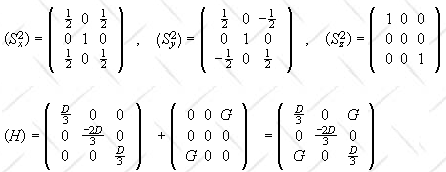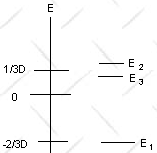
Problem:Suppose that an ion having s = 1, l
= 0 is surrounded by an array of charges.
Its Hamiltonian is H = D[Sz2 - 1/3 s(s + 1)I] + G(Sx2
- Sy2)
. Assuming D/3 > G > 0.
(a) Construct the energy matrix for this Hamiltonian.
(b) Solve exactly for the energy eigenvalues.
(c) Sketch the energy levels.
Given: I is the identity matrix.

In this problem the units are chosen such that ħ = 1.
Solution
- (a) You can solve this problem without knowing anything about the physical quantities
represented by the operators S2, L2, Sx, Sy,
and Sz. L2 and S2 represent the operators
for the square of the orbital angular momentum and the spin angular momentum of a spin 1
particle and Sx, Sy, and Sz represent the
operators for the Cartesian components of the spin. The eigenvalues of S2
are s(s + 1)ħ2 and the eigenvalues
of L2 are l(l + 1)ħ2. In this problem the
units are chosen such that ħ = 1.
Sz is diagonal. The basis picked is an eigenbasis of Sz.
The eigenvalues of Sz are 1,0,-1.
H = D[Sz2
- 1/3 s(s + 1) I] + G(Sx2 - Sy2).
D and G are numbers, Sx2, Sy2,
and Sz2 are matrices and s(s + 1) is a number.
s = 1, s(s + 1) = 2, (1/3)s(s + 1) = 2/3.

(b)

-(D/3 - β)2(2D/3 + β) + G2 (2D/3 + β) = 0.
Either
(2D/3 + β) = 0, β1 = -2D/3, or D/3 - β = ąG, β2
= D/3 + G, β3 = D/3 - G.
The eigenvalues are β1, β2, and β3.
The eigenvector corresponding to the eigenvalue
β1, β2, and β3 are
 .
.
(c) We have found the eigenbasis of H.
The eigenvalues are E1 = -2D/3 < 0, E2 = D/3 + G > 0,
E3 = D/3 - G > 0.

Problem:
The angular momentum operators {Jx, Jy, Jz} are central to quantum theory.
States are classified according to the eigenvalues of these operators when
J is conserved by the respective Hamiltonian H.
(a) What condition(s) is (are) necessary for all eigenstates of H to be
eigenstates of J?
An eigenstate of J is usually specified by |j,mz>,
where J2|j,mz> = j(j + 1)ħ2|j,mz>
and Jz|j,mz> = mzħ|j,mz>.
(b) We can substitute Jx or Jy for Jz
in (a). However a state cannot be simultaneously an eigenstate of Jz
and Jx. Derive the commutation relation for the angular
momentum operators Jx and Jz,
(i.e. [Jx,Jz] = -iħJy)
from the definition of the linear momentum operator.
(c) Prove that it is indeed possible for a state to be simultaneously an eigenstate of
J2 = Jx2 + Jy2 +Jz2
and Jz.
Solution:
- Concepts::
Commuting operators
- Reasoning:
Two commuting observables can be measured
simultaneously, i.e. the measurement of one does not cause loss of information
obtained in the measurement of the other. If we measure a complete set of commuting observables (C.S.C.O.), then the state
of the system after the measurement is one element of an unique eigenbasis. The
results of the measurement specify the state completely.
- Details of the calculation:
(a) It is possible to specify a common eigenbasis of two operators if they
commute. If one of the operators is non degenerate, then all of its
eigenvectors are also eigenvectors of the other operator. In order for all
eigenstates of H to be eigenstates of J2 and Jz
we need [J2,H] = 0 and [Jz,H] = 0
and H is non degenerate. (States with different j or mz
must have different energy eigenvalues E.)
b) Assume the classical relationship J = r × p.
Jx = ypz - zpy, Jy = zpx
- xpz, Jz = xpy - ypx.
For the quantum mechanical operators we then have
Jx = YPz - ZPy, Jy = ZPx
- XPz, Jz = XPy - YPx.
[Jx,Jz] = [YPz - ZPy,XPy - YPx]
= [YPz,XPy] + [ZPy,YPx] - [YPz,YPx]
- [ZPy,XPy]
0
0
= [YPz,X]Py + X[YPz,Py] + [ZPy,Y]Px
+ Y[ZPy,Px]
0
0
= Z[Py,Y]Px + X[Y,Py]Pz =
-iħ(ZPx
- XPz) = -iħJy.
(In general
[Ji,Jj] = iħεijkJk.)
(c)
J2 = Jx2 + Jy2 + Jz2.
If [J2,Jz] = 0 then it is possible to
find simultaneous eigenstates.
[J2,Jz] = [Jx2,Jz] +
[Jy2,Jz] + [Jz2,Jz]
= Jx[Jx,Jz] + [Jx,Jz]Jx
+ Jy[Jy,Jz] + [Jy,Jz]Jy
= -iħ(JxJy + JyJx) + iħ(JxJy
+ JyJx) =0.
Problem:
The matrix σx
is defined by
 .
.
Prove the relation exp(iασx) = I cosα + i σx
sinα, where I
is the 2 x 2 identity matrix.
- Solution:
Functions of operators
Let σx be the matrix of the Hermitian
operator Sx in the {|1>,|2>} basis, <i|Sx|j>
= (σx)ij.
exp(iαSx) = cos(αSx) + i sin(αSx) = ∑n=evenfnαn
Sxn + i ∑n=oddfnαn Sxn.
<i|Sx2|j> = ∑k=12<i|Sx|k><k|Sx|j>
= ∑k=12(σx)ik(σx)kj
= δij.
Therefore Sx2 = I, Sxn (n=even) = I, Sxn (n = odd) = ISx = Sx.
exp(iαSx) = ∑n=evenfnαn
I + i ∑n=oddfnαn Sx = I cosα + i
Sx sinα,
exp(iασx) = I cosα + i σx sinα.





 .
.
 .
.